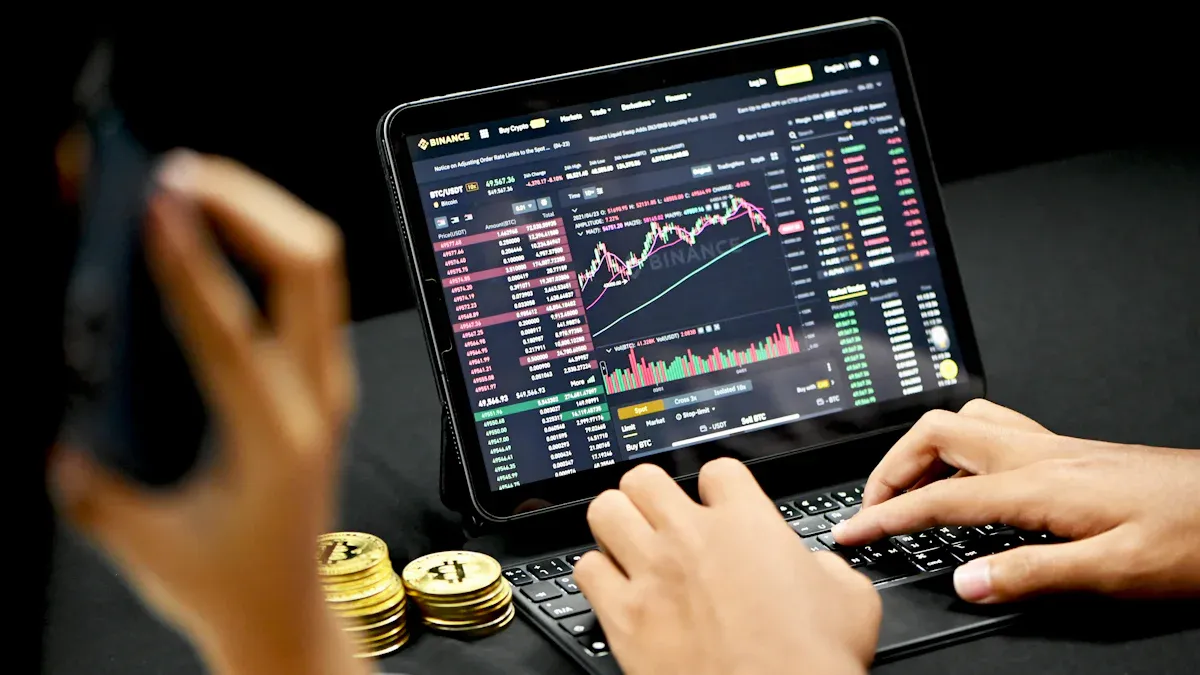- EasyCard
- Trade
- Help
- Announcement
- Academy
- SWIFT Code
- Iban Number
- Referral
- Customer Service
- Blog
- Creator
Is Copy Trading Really Suitable for You? A Comprehensive Interpretation from Principles to Risks

Image Source: unsplash
Have you ever wondered, is copy trading right for you? Many investors choose copy trading mainly because:
- You can learn strategies by observing professional traders;
- You can save a lot of time on research and analysis;
- You can follow multiple traders to achieve portfolio diversification;
- You can clearly see each trader’s past performance;
- You can also choose different strategies based on your own needs, reducing investment costs.
However, while copy trading offers convenience, it also carries certain risks. You need to carefully assess whether it suits you, based on your financial situation, risk tolerance, and investment experience.
Key Points
- Copy trading is suitable for beginners, allowing them to learn investment strategies by observing professional traders and quickly get started.
- Choosing the right trader and platform is crucial—pay attention to their track record and risk management skills.
- Although copy trading saves time, you still need to rationally assess risks and avoid blindly following others.
- Diversified portfolios can reduce risks, so it is recommended to copy multiple traders simultaneously to spread risk.
- Regularly monitor investment performance and adjust strategies in time to ensure risks remain controllable.
Is Copy Trading Right for You?
Suitable Groups
You may find copy trading suitable, especially in the following situations:
- You are new to investing, lack professional knowledge, and hope to get started quickly by leveraging others’ experience.
- You want to save time and don’t want to spend a lot of effort studying markets and analyzing data.
- You are willing to learn investment skills by observing professional traders’ strategies.
- You have a certain level of risk tolerance and can accept fluctuations and drawdowns in the investment process.
- You want to diversify your portfolio to spread risk.
Copy trading provides a lower market entry barrier for beginners. You can leverage professional traders’ strategies and insights to improve your chances of success. Social trading platforms display top traders’ performance history to help you evaluate risks and potential returns.
Successful copy trading participants often choose high-risk, high-volatility stocks. They trade frequently and are easily influenced by social factors. If you enjoy frequent operations and are willing to try different strategies, copy trading may suit you better.
Unsuitable Groups
You may find copy trading unsuitable, especially if:
- You are extremely sensitive to investment risks and cannot tolerate capital fluctuations.
- You lack understanding of trading strategies and are prone to blindly follow others.
- You rely too much on the copied trader’s performance and lack independent judgment.
- You want stable, low-risk, long-term returns.
- You don’t have enough funds to diversify and can only follow a single trader.
Beginners without sufficient risk tolerance or understanding of trading strategies are likely to incur losses in copy trading. If you want to completely avoid risks or only pursue steady returns, you should carefully consider whether to participate.
Judgment Standards
You can judge whether copy trading is right for you through the following standards:
| Standard | Explanation |
|---|---|
| Financial | You have spare funds, can diversify investments, and avoid overconcentration. |
| Risk tolerance | You can accept fluctuations and drawdowns without panicking at short-term losses. |
| Investment experience | You understand basic investment principles and can evaluate traders’ strategies and performance. |
| Clear goals | You know whether your goal is high returns or steady growth. |
| Platform choice | You choose transparent, compliant platforms, paying attention to track records and risk management. |
Financial experts suggest the following when selecting copy trading:
- Choose traders who rank high on platforms and have verifiable trading records.
- Prioritize traders with clear strategies and transparent risk levels.
- Look for stable returns both short and long term, not just recent performance.
- Observe how traders perform in different market conditions to ensure adaptability.
- Analyze win rates, drawdown depth, and recovery speed to evaluate risk management.
You can also set maximum drawdown limits, use position size controls, and regularly rebalance portfolios to maintain diversification and reduce reliance on any single trader.
You can self-test: if you have spare funds, can tolerate some risks, are willing to learn, and continuously follow market trends, copy trading may suit you. If you only want stable returns or cannot accept fluctuations, it is better to choose other investment methods.
When deciding whether to participate, consider your finances, risk tolerance, and investment experience. Only by clarifying your needs and goals can you make a wise choice.
Principles of Copy Trading
Operating Mechanism
In copy trading, you link your account with that of a professional trader. Every time the trader buys or sells, your account automatically mirrors the same action. This way, you directly replicate their strategies and decisions. You don’t need to monitor markets or place trades frequently. By choosing the right trader, you can follow their actions and experience professional investment processes.
Copy Trading Models
Currently, there are two main models. The first is fully automated copy trading. You select one or more traders, and the system automatically copies all their trades. The second is semi-automated copy trading. You can see the trader’s trade suggestions and decide whether to follow. Fully automated mode suits those who want to save time and effort, while semi-automated mode suits those who want to retain some control. Different platforms also provide risk control tools, such as setting maximum loss limits.
Platform Process
To start copy trading, you can follow these steps:
- Choose a suitable copy trading platform. Focus on regulatory compliance and transparency.
- Evaluate the traders you want to copy. Check their historical performance, risk level, and trading style.
- Set investment parameters. Define the trade amount proportion and maximum loss limit.
- Start copying. The system will automatically mirror traders’ operations, and you can monitor performance anytime.
Copy trading suits you only if you understand these principles and processes. Only by mastering mechanisms and models can you control risks better and achieve your investment goals.
Can You Make Money with Copy Trading?

Image Source: pexels
Profit Potential
You may wonder, can copy trading actually make money? Actual returns depend on strategies and risk appetite. The table below shows typical returns:
| Trading type | Avg. monthly return | Annual return range |
|---|---|---|
| Conservative | 1-3% | 12-36% |
| Moderate | 4-8% | 48-96% |
| Aggressive | 9-15% | 108-180% |
According to eToro research, beginners using copy trading achieved 12% higher average returns in the first six months than independent traders. By choosing the right traders and diversifying investments, you improve your profit potential.
Common Misunderstandings
Many beginners misunderstand copy trading. See the table below:
| Misunderstanding | Reality |
|---|---|
| Copy trading is a get-rich-quick scheme | It doesn’t guarantee success; research and risk management are required. |
You may think copy trading is a shortcut, but its true value lies in learning from experts, diversifying investments, and improving decision-making. Markets change quickly; profits are not guaranteed.
Case Analysis
Profitability in copy trading depends on many factors:
- Overconfidence bias—attracted by short-term high returns, ignoring long-term risk.
- Loss aversion—panic selling in downturns hurts returns.
- Confirmation bias—copying traders that match your views, ignoring risks.
Key points:
- Choose traders whose risk profile matches your goals.
- Platform performance, market environment, and execution speed affect results.
- Monitor performance, diversify portfolios, and manage slippage/delays.
If you want to know if copy trading suits you, consider your goals, risk tolerance, and willingness to learn.
Risks of Copy Trading

Image Source: pexels
Fund Safety
First, focus on fund safety. Copy trading involves market risks—price fluctuations directly affect your results. Platforms may charge fees (profit share, subscription), reducing returns. Non-transparent platforms may expose you to fraud. Choosing regulated, transparent platforms reduces fund misappropriation risks.
Watch out: market risk, dependence on traders, costs, potential scams, all frequently cited by regulators.
Trader Selection
Evaluate traders with these criteria:
| Standard | Explanation |
|---|---|
| Performance | Look for long-term stability, not just short-term highs. |
| Drawdown | Prefer traders with <25% max drawdown for stronger risk control. |
| Win rate & P/L ratio | Review win rate and average profit vs. loss. |
| Risk score | Choose mid/low-risk traders, check stop-loss and diversification. |
| Community feedback | Read user reviews to gauge transparency/reliability. |
Also, check how traders adapt to different markets.
Platform Risks
Some platforms have hidden pricing and non-transparent fees. Volatility can cause execution delays and slippage. Choose regulated platforms, read fee structures, and avoid opaque pricing.
- Hidden pricing affects returns.
- Delay & slippage reduce execution accuracy.
Volatility & Drawdowns
Portfolios may be riskier than fund managers’ products. Personal traders lack institutional risk controls. Monitor drawdowns and diversify funds to avoid major losses from a single trader.
Choosing Traders and Platforms
Trader Evaluation
Review long-term performance, not just recent results. Monitor regularly and analyze risk management. Look at drawdowns, adaptability, and stability in various markets.
Tip: Check win rates, avg. profit/loss ratios, and trade frequency. Ensure the trader’s style fits yours.
Platform Screening
Choose regulated platforms (U.S., HK, etc.). Review fee structures. Ensure transparency of performance/risk indicators. Look for user-friendly interfaces, mobile support, and educational resources.
- Regulatory compliance: ensures fund/data safety.
- Trader diversity: more styles to choose from.
- Transparent fees: avoid hidden costs.
- Risk management tools: stop-loss, diversification.
Avoiding Traps
Beware of scams: fake performance, Ponzi schemes, pump-and-dumps. Avoid promises of guaranteed returns or rushed sales pitches. Protect personal info and stop when suspicious.
Remember: if in doubt about a platform or trader, it’s safer to wait than rush in. Safety first.
Process and Considerations
Copy Trading Steps
Follow these steps:
- Register and verify your account (e.g., BitMEX).
- Browse copy markets, check traders’ performance and risk.
- Choose traders, set allocation and risk parameters.
- Start copying; system mirrors trades. Monitor anytime.
Suggestion: regularly check results and adjust strategy to keep risks controllable.
Common Questions
See expert answers:
| Question | Expert Answer |
|---|---|
| How to choose traders? | Check performance, risk, style, and expertise. |
| Can I adjust allocations? | Yes, based on performance and risk appetite. |
| What to monitor? | Results, risk management, market context. |
| Are there fees? | Some platforms charge fees or pay copied traders. |
| Can I close trades manually? | Most platforms allow manual exits. |
| Is copy trading for beginners? | Yes, it suits beginners learning from pros. |
| Can leverage be used? | Some platforms allow leverage; understand risks. |
| How to start? | Open an account, pick traders, allocate funds, monitor. |
| Guaranteed profits? | No, results depend on many factors. |
Risk Management
Experts suggest these strategies:
| Strategy | Explanation |
|---|---|
| Diversification | Copy multiple traders to spread risk. |
| Reserve funds | Keep extra cash for better opportunities. |
| Evaluate traders | Choose by risk control ability, not just popularity. |
| Exit plan | Set stop-loss points, know when to stop copying. |
| Avoid overmanagement | Don’t over-intervene; avoid emotional decisions. |
Regularly review your portfolio, adjust when needed, and build a scientific risk system for better results.
Pros and Cons
Main Advantages
- Access professional knowledge directly by learning strategies.
- Save time on research and strategy building.
- Learn quickly in practice, building market intuition.
- Diversify portfolios by following multiple traders.
- Reduce emotional influence via automation.
Main Disadvantages
| Fee type | Impact |
|---|---|
| Platform fee | 1-2% annual management |
| Performance | 5-20% profit share |
| Spread markup | 0.1-2 pips per trade |
| FX conversion | 0.5-1% per trade |
- Overdependence on others, lack of personal skill.
- Limited control of trades.
- Hidden costs cut into profits.
- Mismatched trading styles cause divergence.
- Different risk tolerances cause losses.
Also, “finfluencers” may promote unverified strategies, increasing difficulty of selection. Following poor traders can mean big risks.
Suitable Summary
Beginners can quickly connect and copy trades with minimal setup. Those unable to monitor markets can benefit from automation. More experienced investors can diversify further. Those wanting to save research time also benefit.
When deciding, consider your learning willingness, time, and risk appetite. Judge rationally if it suits you.
You now understand pros/cons. Automation saves time, diversification reduces risk, but volatility and execution delays remain. To judge if copy trading fits you, start small, use stop-loss, and diversify. Continuous learning and community participation help improve judgment.
FAQ
How much starting capital is required?
You can begin with as little as $100 on some platforms. Adjust amounts based on your funds.
Can I stop copying anytime?
Yes, most platforms let you manually stop at any time.
Does copy trading affect fund safety?
Choose regulated platforms, e.g., those working with licensed banks in HK. Transparency and compliance improve safety.
Can I copy multiple traders?
Yes, you can copy several traders simultaneously to spread risk.
Is copy trading suitable for long-term investment?
Yes, but you must review traders’ performance regularly and adjust strategies to meet your goals.
Having dissected copy trading’s mechanics and risks, you’re equipped to gauge if it fits your style, but high cross-border fees, currency volatility, and offshore account complexities can thwart replicating U.S. stock or forex trader strategies, especially for swift market responses. Picture a platform with 0.5% remittance fees, same-day global transfers, and zero-fee contract limit orders, enabling seamless copy trading via one account?
BiyaPay is tailored for copy traders, offering instant fiat-to-digital conversions to mirror trader signals agilely. With real-time exchange rate query, monitor USD shifts and remit at optimal moments to cut costs. Covering most regions with instant arrivals, it powers quick emulation of pro traders’ scalping or trend plays. Crucially, trade U.S. and Hong Kong markets through a single account, leveraging zero-fee contract limit orders to replicate high-win-rate setups.
Whether you’re a novice learning pro tactics or a seasoned diversifier, BiyaPay empowers your journey. Sign up now, visit stocks for U.S. copy opportunities—quick setup unlocks cost-effective, disciplined investing. Join global traders and make copy trading work for you!
*This article is provided for general information purposes and does not constitute legal, tax or other professional advice from BiyaPay or its subsidiaries and its affiliates, and it is not intended as a substitute for obtaining advice from a financial advisor or any other professional.
We make no representations, warranties or warranties, express or implied, as to the accuracy, completeness or timeliness of the contents of this publication.




Contact Us
Company and Team
BiyaPay Products
Customer Services
is a broker-dealer registered with the U.S. Securities and Exchange Commission (SEC) (No.: 802-127417), member of the Financial Industry Regulatory Authority (FINRA) (CRD: 325027), member of the Securities Investor Protection Corporation (SIPC), and regulated by FINRA and SEC.
registered with the US Financial Crimes Enforcement Network (FinCEN), as a Money Services Business (MSB), registration number: 31000218637349, and regulated by FinCEN.
registered as Financial Service Provider (FSP number: FSP1007221) in New Zealand, and is a member of the Financial Dispute Resolution Scheme, a New Zealand independent dispute resolution service provider.



















